Best
NEAR FIELD MONITORS
-
Overall: • Powerful 4-Inch Studio Monitor - Perfect for Mixing and Mastering
-
Best Feature: • Directivity Control Waveguide (DCW™) Technology
-
TedScore™: 9/10
Best
BUDGET STUDIO MONITORS
-
Overall: 5-Inch, Bi-Amplified Studio Monitor
-
Best Feature: Room Control and High Trim Control for Optimisation
-
TedScore™: 10/10
Best
ACTIVE MONITORS
-
Overall: New Generation Studio Monitor With 5-Inch Woofer
-
Best Feature: LCD Display for Easy EQ Visualisation
-
TedScore™: 8/10
Hundreds of studio monitors catch the eye these days, with a dazzling array from budget-friendly ones to those that cost an arm and a leg, plus everything in between.
What caused this boom in monitor demand however, was the explosion on home recording that’s happened over the last twenty years.
Many young producers have entered the profession looking to make great music on a budget and this is who this article is aimed at.
But, before we can talk about the best cheap studio monitors, we first must understand what they are, what to expect from them and, lastly, help you understand what you should look for in a pair of studio monitors.
What is a studio monitor?

Many people will say that studio monitors are just speakers that you use in a studio. This is true to an extent but it doesn’t fully encapsulate the truth.
Regular speakers that come with a stereo will often be built to enhance certain frequencies which make the music that comes from them sound more appealing.
Studio monitors, on the other hand, don’t color or shape the sound in any way.
They are said to have a flat frequency response. This means that they are a much better tool for mixing, mastering and music production because they give a very honest sonic impression of the music you are working on.
What to expect from cheap studio monitors
Budget studio monitors, despite the label they are given, are actually something of a diamond in the rough for most music producers.
First of all, for any producer who is used to working with regular speakers or with headphones, even a relatively cheap pair of studio monitors will be a huge leap forward in quality.
You’ll be able to hear individual instruments with much more clarity, the frequencies in your music will be much clearer, you’ll notice panning (whether a sound is on the left, right or in the middle of a mix) and you’ll be able to hear a lot more detail in general within your music.

You might expect that if you pay more money for monitors you’ll be able to hear music – and as such, produce it – with more and more clarity and precision.
Wrong!
The room you have your set of studio monitors in matters just as much as the monitors themselves.
Many top class producers will say that unless you have a room that’s been acoustically treated then spending more than 400 on a set of studio monitors is actually a waste of money because you’ll never get the best out of them in a bad room.
For this reason, cheap studio monitors are the way to go for the vast majority of producers.
Active v passive speakers – what’s the difference?
Despite the fact that budget studio monitors are often the best option for a lot of producers, this doesn’t mean that you should go out and buy any old pair of affordable studio monitors.
There are still important differences between them that we must understand.
One such difference is the difference between active and passive monitors.
The term “active” means that the monitor has an amplifier that powers it built into the monitor itself.
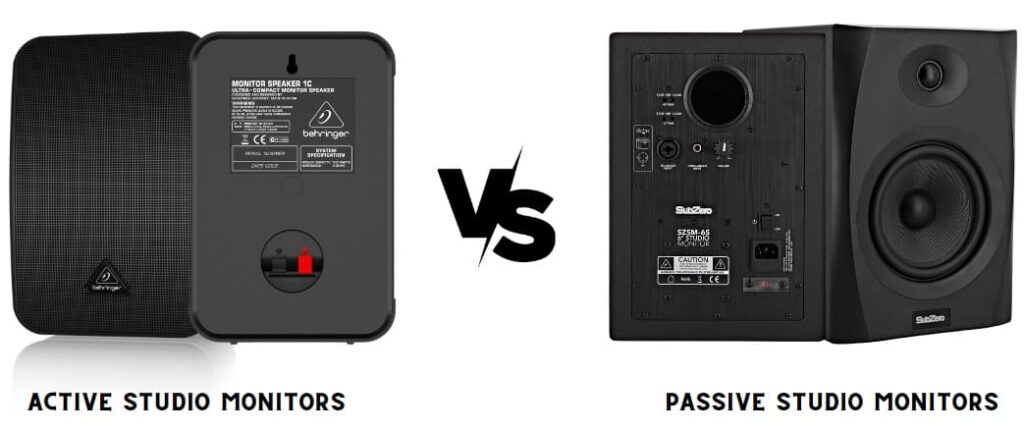
“Passive” monitors don’t have this and rely on an eternal power amp to make them work.
This can affect the sound and also how convenient passive monitors are to use.
Even though the music production world grew up (so to speak) with passive monitors, many professional studios have switched to active monitors quite happily.
One reason could be that active monitors simply take up less space. Power amps for passive speakers can be quite large and space in both professional and home studios is important.
Second, many producers will worry about having a power amp that’s suitable for their passive studio monitors. This issue becomes more complex should the passive studio owner ever want to upgrade or expand their set up.
However, if you’ve got an active studio monitor setup then you can be assured that the power amp is a good match for the monitors you have because it’s actually built into the monitor itself!
Monitors v speakers
Whilst some people will refer to studio monitors as “studio speakers”, it’s important to realise that they are talking about studio monitors and not the kind of speakers that will come with a regular stereo.
We’ve already been through the technical differences above so I won’t bore you with those details again, but the main point to takeaway is that, whether you call them studio monitor speaker or studio speakers, they are a much more precise, specialized and surgical tool to work with.

You’ll be able to hear more with studio monitors, adjust your mixes with greater clarity and hear with a kind of precision that you simply can’t get from regular stereo speakers.
Tweeters & woofers
Tweeters and woofers are something you should consider when looking at the budget studio monitors available to you.
They will help you hear with the clarity and precision that studio monitors are famed for.
However, what do tweeters and woofers actually do? Let’s start with tweeters.
Tweeters are the part of your monitors that produce high frequency sounds. Typically they are the smaller speakers that sit at the top of a monitor.
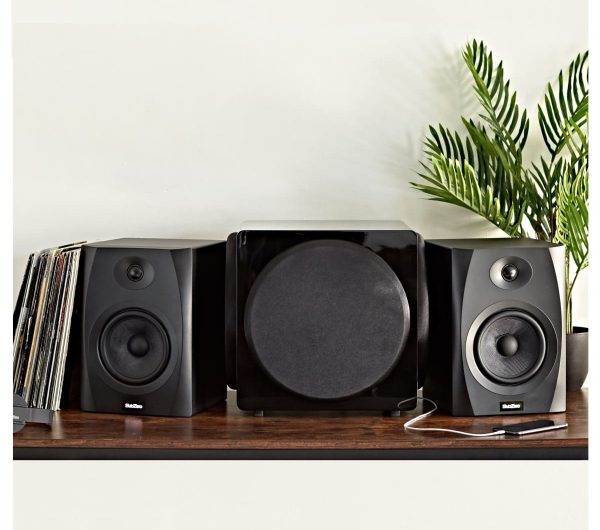
So if you’ve just bought a shiny pair of active studio monitors and you see a small speaker at the top, that’s the tweeter.
Whilst there are several different types of tweeter for several different types of speakers, most of the budget studio monitor options you’ll see on the market will have a silk dome tweeter of some kind.
But, to be honest, you don’t need to worry about that. If the monitor sounds good then that’s all that matters.
Woofers are designed to handle low register frequencies. This is what enables monitors to have their incredible, full and bass-laden sound.
Again, most studio monitors will have woofers built in so you don’t need to worry about buying them on their own.
Room size
Each producer will have different needs and, as such, they will need different spaces to work from.
Some producers will only have a computer and a small keyboard so might be fine working from the spare room of their home.
Others will have several computer setups, a wide range of acoustic instruments and will also need the space to record large bands.
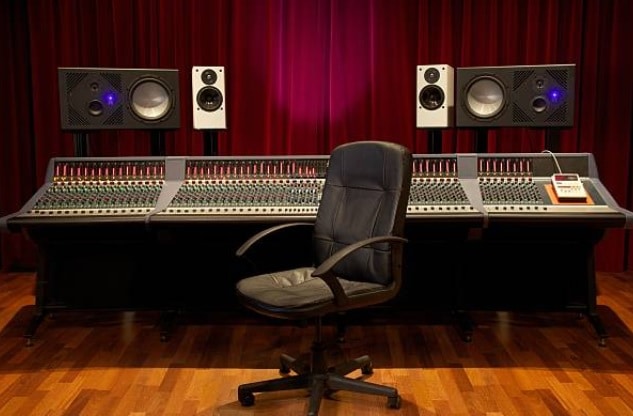
Regardless of what you want to use a studio for, there are a few things you should always consider when hiring or buying a space to build your studio in.
Consider the following…
Near field monitors
Far-field monitors are much more specialized in their use. As the name suggests, these are monitors that are designed to project sound much further than near field monitors.
Whilst you will occasionally find them in larger or professional recording studios, they are often used in places like movie theatres because they can not only fill a large space, they also sound better when they are in bigger rooms.

Given what we just learned about having reflections in a mixing room, far-field monitors are often unsuitable for home recording because they would create far too many reflections.
They also tend to have a much greater capability to low output frequencies. Some can go as low as 15hz, which is actually out of the range of human hearing!
But, if you were to use a pair of far-field monitors in your small home studio, then the chances are that you’d flood your ears with bass and make cuts and changes to your mix that is actually ill-informed.
For this reason, most home producers who are hunting for budget studio monitors will stick with near field monitors.
How much space do you have for your equipment?
How big should your studio be? Put it this way, how long is a piece of string?
Put simply, think about what you’ll use the space for and how much gear you have. Not about an arbitrary “ideal” size that you’ll find listed on an online chat forum.
Go and look at potential spaces (if you’re renting) and ask yourself; do you have space for all the audio interfaces that you have?
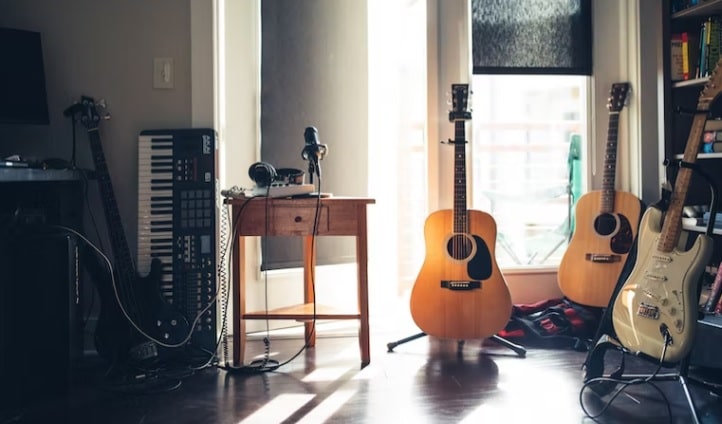
Does the room your are viewing have space for the grand piano you intend on buying? Will you be able to record vocalists in this space?
All these things really matter, and there’s no one-size-fits-all answer here. If you feel a space does or doesn’t meet your needs, then so be it.
5 CHEAP STUDIO MONITORS

DESIGNED FOR: Small Spaces
COMES WITH: Standard monitor
FEATURES: Great for all kinds of music
KRK ROKIT
When you check the price above, you’ll see there are loads of great places to buy this item. Our personal favorite is Gear4music.
It is the largest music retailer in the UK and fast becoming the most respected online music shop in the US too. Their customer service is excellent, they have competitive prices, really fast shipping, and usually have the longest guarantee.
Most professional musicians use Gear4music, so there is no reason why you shouldn’t too!
- Affordable
- Balanced sound
- Don’t take up much space
- Mid range can sound a little “boxy”
The professional musician who wrote this article combined many things,
from the product build, manufacturer’s reputation through to feedback
from other users, to create our famous TedScore™.
The pros of this studio monitor
The KRK ROKITs are a brand that is trusted by many home producers, and it’s easy to see why. They sound great, don’t take up a lot of room, are affordable, and they also look cool!
The cons of this studio monitor
If I had to make one criticism of the ROKIT, it would be that the mid-range sounds a little “boxy”, by which I mean that it sounds quite detached from the rest of the mix.
Having studio monitors color the sound this way could be a concern for some producers.

DESIGNED FOR: Home producers
COMES WITH: Standard monitor
FEATURES: Great for all kinds of music
Yamaha HS5
When you check the price above, you’ll see there are loads of great places to buy this item. Our personal favorite is Gear4music.
It is the largest music retailer in the UK and fast becoming the most respected online music shop in the US too. Their customer service is excellent, they have competitive prices, really fast shipping, and usually have the longest guarantee.
Most professional musicians use Gear4music, so there is no reason why you shouldn’t too!
- Affordable
- Bi amplified
- Near field monitor
- No woofer included
The professional musician who wrote this article combined many things,
from the product build, manufacturer’s reputation through to feedback
from other users, to create our famous TedScore™.
The pros of this studio monitor
The biggest plus of these monitors is the room control and high trim control features which allow you to optimize the speakers for the room you work in.
Even if you don’t have a great sounding room, you can still get these monitors to give you a great sound!
The cons of this studio monitor
This may or may not be a con, depending on how you want to use these monitors in your set-up, but they don’t come with a woofer.
They do handle bass well on their own, but some producers, typically those with a more advanced set-up, will want to have a separate woofer to handle bass.

DESIGNED FOR: Home producers
COMES WITH: Standard monitor
FEATURES: Ideal for mixing and mastering
PreSonus Eris E5
When you check the price above, you’ll see there are loads of great places to buy this item. Our personal favorite is Gear4music.
It is the largest music retailer in the UK and fast becoming the most respected online music shop in the US too. Their customer service is excellent, they have competitive prices, really fast shipping, and usually have the longest guarantee.
Most professional musicians use Gear4music, so there is no reason why you shouldn’t too!
- Affordable
- Enhanced bass response
- Near field monitor
- The reproduce sound isn’t as clear as other options
The professional musician who wrote this article combined many things,
from the product build, manufacturer’s reputation through to feedback
from other users, to create our famous TedScore™.
The pros of this studio monitor
The Eris E5s have a great frequency response which makes them ideal for mixing and mastering. They are also one of the most affordable options on this list.
So if you’re making your first steps into the world of home production, these would be a great first pair of monitors.
The cons of this studio monitor
Whilst they do have a great sound quality, there are other options on this list which have a superior quality for only a little more money.
They also don’t offer the same innovative features such as room optimization that the Yamaha speakers do.

DESIGNED FOR: Professional home producers
COMES WITH: Standard monitor
FEATURES: Active crossover filters for room optimization
Genelec 8020D
When you check the price above, you’ll see there are loads of great places to buy this item. Our personal favorite is Gear4music.
It is the largest music retailer in the UK and fast becoming the most respected online music shop in the US too. Their customer service is excellent, they have competitive prices, really fast shipping, and usually have the longest guarantee.
Most professional musicians use Gear4music, so there is no reason why you shouldn’t too!
- Great room optimization
- Incredible sound
- Near field monitor
- Less affordable
The professional musician who wrote this article combined many things,
from the product build, manufacturer’s reputation through to feedback
from other users, to create our famous TedScore™.
The pros of this studio monitor
The 8020D’s from Genelec are at the more costly end of the spectrum but with good reason. They are very good!
They have an incredibly balanced sound, and they offer brilliant room optimization.
No wonder, so many professionals use them in their home studios. These really are a contender for the title of best budget studio monitors
The cons of this studio monitor
As with all things that are good, they do cost a little more money. This is something you’ll have to think about and whether or not you should spend the money is something you can only answer for yourself.

DESIGNED FOR: Professional home producers
COMES WITH: Standard monitor
FEATURES: Active crossover filters for room optimization
SubZero Active 6
When you check the price above, you’ll see there are loads of great places to buy this item. Our personal favorite is Gear4music.
It is the largest music retailer in the UK and fast becoming the most respected online music shop in the US too. Their customer service is excellent, they have competitive prices, really fast shipping, and usually have the longest guarantee.
Most professional musicians use Gear4music, so there is no reason why you shouldn’t too!
- Great room optimization
- Active monitors
- Near field monitor
- Less affordable
The professional musician who wrote this article combined many things,
from the product build, manufacturer’s reputation through to feedback
from other users, to create our famous TedScore™.
The pros of this studio monitor
These monitors from SubZero offer a great sound and are also active, so they’ll take up less space.
If you’re looking for the sweet spot between affordability, sound quality and space-saving, this could be the option for you!
The cons of this studio monitor
As good as these speakers are, they don’t offer the same sound quality that the Genelec’s do. This is something you’ll have to weigh up for yourself, though.
More money doesn’t always mean it will be better for you personally!
Best value for money studio monitor
They may not offer the same quality as the Genelec monitors do, but I feel that the best budget studio monitors are the Yamaha HS5s.
They offer a great sound with affordability and room optimization. For many producers on a budget, that’s hard to beat!

DESIGNED FOR: Home producers
COMES WITH: Standard monitor
FEATURES: Great for all kinds of music
Yamaha HS5
When you check the price above, you’ll see there are loads of great places to buy this item. Our personal favorite is Gear4music.
It is the largest music retailer in the UK and fast becoming the most respected online music shop in the US too. Their customer service is excellent, they have competitive prices, really fast shipping, and usually have the longest guarantee.
Most professional musicians use Gear4music, so there is no reason why you shouldn’t too!
- Affordable
- Bi amplified
- Near field monitor
- No woofer included
The professional musician who wrote this article combined many things,
from the product build, manufacturer’s reputation through to feedback
from other users, to create our famous TedScore™.
CONNECTIVITY
Different monitors will use different connections, which can be a source of confusion and frustration for many producers.
On the whole, connections tend to be simpler with active monitors because you don’t have the complication of putting an external power amp between your computer and the monitors.

Plus, active monitors tend to come with everything they need to function already built into the monitor itself.
However, should you be having issues, then I recommend you read this great article or go to a local dealer for help.
Tuning options
Tuning or “calibrating” studio monitors is a complex task. It often requires a professional to do it for you.
And whilst some monitors come with in-built technology that can help you, it’s best to read up on this task before starting.
Here’s a great article to help you get started.
HOW TO BUY ON A BUDGET
The best way to buy on a budget is to simply be honest with yourself about what your needs are and what space you have.
Yes, it can be nice to buy the best gear out there and be able to brag to your friends that you’ve spent however many thousands of pounds on the latest tech out there, but at the end of the day, you need to ask yourself, “will that help me make better music?”.
If the answer is no, then you’ve probably made the wrong decision.
The best budget studio monitors will be different depending on who you are, why you’re buying and where you want to use them.
Think about the size of the room you work in, the kind of music you work on and how you personally want to work.
Will you prefer to have near field monitors?
Do you want the convenience of having active monitors?

Do you have a preference for passive monitors?
Do you have a strict budget that you must stick to?
All these things really do matter, so don’t feel bad about not getting the latest gadget or the fancy special offer.
Worry about getting monitors that are right for you.
Upgrading current equipment
The world of production often moves very quickly, and you’ll need to upgrade your equipment like sample libraries, interfaces, speakers and other software as often as you can to keep pace with the market.
Learning how to use all these new things is also another challenge.
For this reason, it’s a good idea to join some sort of producer community so you can keep up to date with what’s current.
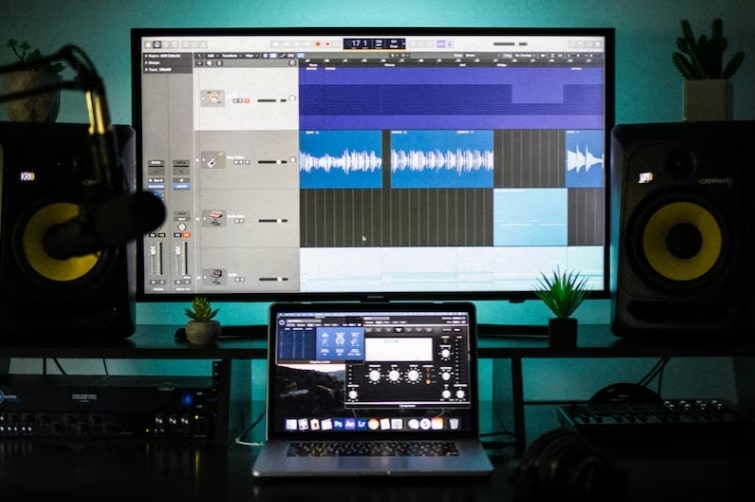
But should you not want to join social media platforms, not feel comfortable posting in online chat forums, or simply prefer to do things a different way, there are plenty of other ways you can keep up to date with the latest gear and trends and methods.
Sound On Sound has an excellent website which is packed full of great product reviews, interviews and advice on almost everything relating to music production, composition and professional music practice you could imagine.
They also have an excellent monthly magazine which is well worth the subscription price.
Should you be looking for a free option, then I highly recommend watching and subscribing to the YouTube channel Pensado’s Place.
The channel has interviews, tutorials and gear reviews that are all conducted by Mike Pensado and his team.
What I really love about this channel is that Mike and the rest of his excellent team are active professionals in the music production business. They’re out there, working in the field (so to speak), and they’re really at the top of their game.
Not only can you be sure that advice from them is well-considered and of the highest quality, but you can also be sure that what they are saying is current and of professional relevance to the field of music production.
So if you’re looking for new studio monitors for your home studio, wondering about how best to use some of the new accessories you’ve bought to produce your next record, or you need to learn more about mic preamps, then you know that Pensado’s Place has you covered.
5 Cheap Studio Monitors
Summary
As with most things, finding the right pair of studio monitors is all about your needs and preferences.
Be honest with yourself about what you like and speak to others in music production communities to get a better insight into what’s on the market.
Read reviews and demos, and if you don’t like what you find, don’t be pressured into buying something just because it’s on sale.
And when in doubt, simply follow the golden rule of sound.
If it sounds good, then it is good!
FAQ's
Personally, I would say the Yamaha HS5s.
Yes. No other speaker will give you the clarity and precision that studio monitors do. Whilst you can use mixing headphones, you still need to know how your music sounds within a room and headphones, by their nature, can’t do that.
That’s up to you, but unless you have a specially treated room, I wouldn’t recommend you spend more than £400.
At least two as you’ll be working in stereo, so you need one monitor for the left and right channels of your mix
I would say the Yamaha HS5s.










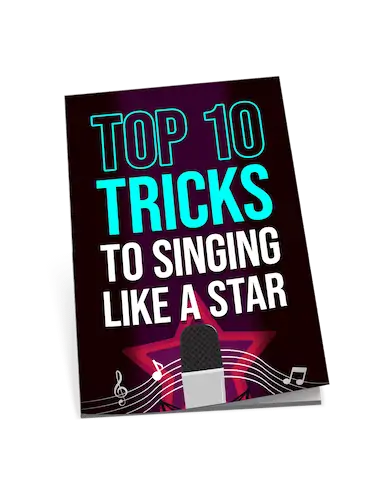
While the focus here is on budget-friendly options, it’s crucial to remember the fundamental principle: ‘You listen with your ears, not your wallet.’ It’s about finding the right tool for the job. What works fantastically in one studio may not translate well in another. Specifications and price tags aside, the ultimate test is how they perform with your setup and ears. Personal experience trumps general opinion every time.
Noticed there’s some chat here about room size, and I’ve gotta add – acoustic treatment made a WORLD of difference in my setup. If you’re running a tight space, definitely consider the near field monitors like the HS5s or the Eris E5. Smaller rooms can greatly benefit from their clarity without overwhelming the space.
Really appreciate the article’s breakdown on active vs passive speakers. It’s details like these that can be super confusing for beginners like myself. Ended up going with the KRK ROKIT based on this guide, and so far, they’re exactly what my home studio needed. Clear, crisp sound with enough bass to feel the music.
Diving into the debate, I reckon there’s no universal ‘best’ when it comes to studio monitors. It’s all about the waves they make with your own setup and space. The PreSonus Eris E5, for instance, totally vibes with my small studio.
Is it just me, or does anyone else imagine how these monitors would sound in a cowboy shootout scene in a movie? Like, you got the KRKs on one side and the Yamahas on the other, and they’re just blasting beats at each other. 😅
A detail often overlooked when choosing monitors is room size and acoustics. The article touches on it, but I can’t stress enough how a good pair of monitors in a poorly treated room won’t live up to their potential. Been using the Yamaha HS5s in a treated room, and they’re as transparent as you’d want for mixing.
Totally psyched to see Genelec 8020D on the list, even though they’re stretching the definition of ‘cheap’ a bit, aren’t they? 😅 My dream is to have a setup with those. Although for now, I’ll be sticking with something a bit less ambitious. Anyone got experiences they wanna share about these? Thinking of saving up!
Can’t help but think about how each of these monitors would handle the punch of live drums. I’ve got the Eris E5s at home, and they’re pretty solid. Wondering if the Genelics would have a tighter response?
Everyone’s always hyping up these cheap studio monitors like they’re the second coming, but at the end of the day, you get what you pay for. Can’t expect top-tier performance from budget gear. Even this list, it’s good, but let’s not pretend any of these will outperform the real high-end stuff.
I just got the SubZero Active 6 because my budget was tight, and honestly, they sound so much better than I thought they would. Happy to see they made the list, makes me feel like I made a good choice for once!